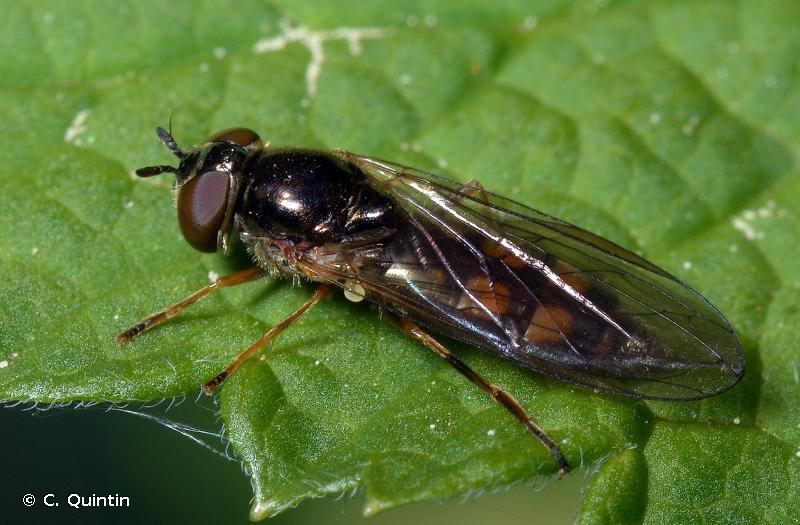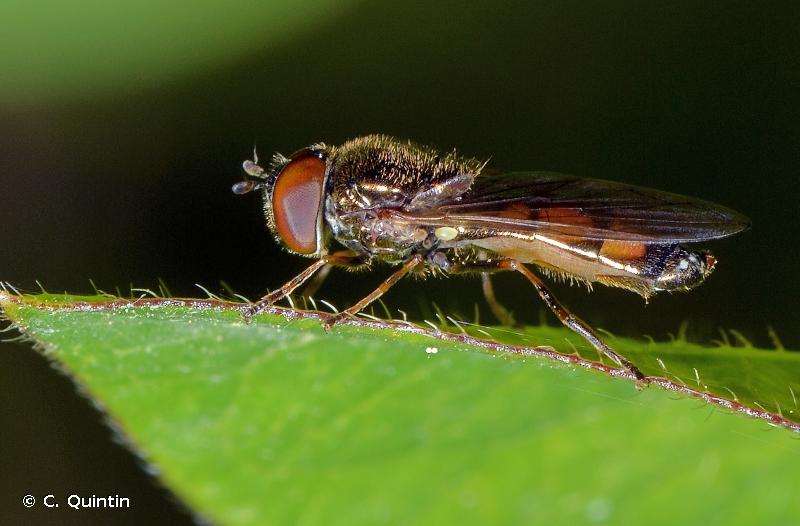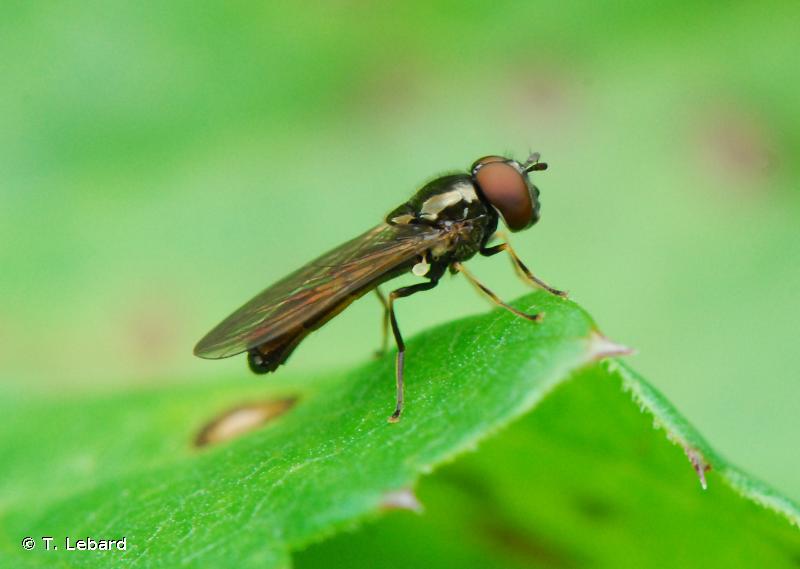
cd_nom

| Author : C. Quintin |
 |
To get the picture, please visit:
Christophe Quintin
email : inpn@mnhn.fr
Despite the Creative Commons license, please inform the author of the use which will be made of his photo

| Author : C. Quintin |
 |
To get the picture, please visit:
Christophe Quintin
email : inpn@mnhn.fr
Despite the Creative Commons license, please inform the author of the use which will be made of his photo

| Author : T. Lebard |
 |
To get the picture, please visit:
T. Lebard
inpn@mnhn.fr
Despite the Creative Commons license, please inform the author of the use which will be made of his photo
Taille :
Très petite, 5 à 7mm.
Diagnose :
Le genre Melanostoma comprend six espèces en Europe mais il est possible que les espèces soient mal définies dans ce genre compliqué mais très commun. On les reconnaît grâce à leurs callus huméraux glabres, des antennes courtes, une tête et un thorax qui sont entièrement noirs et un abdomen relativement allongé. Proche du genre Platycheirus on peut les en différencier grâce au métasternum peu sclérifié et les mâles ont toujours les tibias antérieurs cylindriques. Les mâles ont le second sternite moins de 1,25 fois plus long que sa largeur maximale. La partie médiane du thorax ne comporte aucun poil noir. Les femelles sont encore plus difficilement déterminables.
Facilité d'identification :
Bien que cette espèce soit très commune son identification reste difficile, identification à la loupe binoculaire indispensable.
Confusions possibles :
Confusion possible avec toutes les espèces du genre Melanostoma mais également avec certains Platycheirus.
Période de vol:
Les adultes sont visibles d'avril à octobre en plusieurs générations successives avec des pics en mai, juin et août.
Répartition générale:
Migratrice et on la rencontre de l'Islande et de la Scandinavie jusqu'à la péninsule ibérique, au pourtour méditerranéen et en Afrique du Nord. Présent pratiquement dans toute l'Europe et jusqu'à la côte pacifique en passant par la Sibérie, on la retrouve également sur le continent américain de l'Alaska au Québec.
Habitat et biologie:
C'est une espèce commune occupant une grande diversité d'habitats ouverts et de milieux de transition. Anthropophile on la retrouve également dans le paysage agricole (cultures et prairies pâturées) et semi urbain (parcs et jardins). Les adultes sont régulièrement observés sur les graminées et se posent souvent sur le dessous des tiges et des feuilles dans la végétation basse. Les larves se nourrissent de pucerons sur une large variété de végétaux et peuvent également consommer d'autres larves de diptères.
Speight, M.C.D. (2020) Species accounts of European Syrphidae, 2020. Syrph the Net, the database of European Syrphidae (Diptera), vol. 104, 314 pp., Syrph the Net publications, Dublin.
Thomas Lebard(),2021
Continental
Metropolitan France
Overseas
Marine
Metropolitan France
Overseas
The map presents a summary at the 10 x 10 km grid of the observation data for the species transmitted to the SINP. These data have been subjected to validation filters.
The map presents a reference distribution layer of the species at the scale of departments and marine sectors. The presence and absence data were established by expertise within a network of partners. This reference distribution is used in the validation process of the SINP data at the INPN level.
Corresponds to a report on the basis of at least one observation proved within a period of 10 years (20 years for little-known invertebrates) preceding the year and no presumption of extinction since obtaining the last data nor doubt on reproductive and implemented nature of this population. For migratory species, the presence indicated concerns areas of reproduction.
This status is based on one or more of the following criteria:
This point covers the absence, more difficult by nature to demonstrate than presence. This status is based on one or more of the following criteria:
This status must be assigned to a department in which the presence of the species is casual.
Particular case of absence due to a proven extinction less than a half century ago (older disappearances are treated as "no probable or definite").
In the state of knowledge, we can not comment on the presence or absence in the current department. This is the default status when not comprised in one of the previous categories or whenever there is doubt.
The map shows the global distribution of the species based on GBIF data (Global Biodiversity Information Facility).
